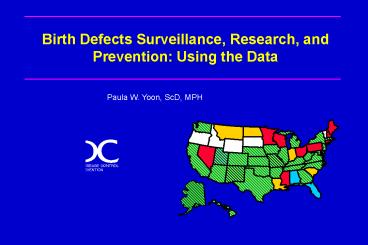Birth Defects Surveillance, Research, and Prevention: Using the Data - PowerPoint PPT Presentation
1 / 25
Title:
Birth Defects Surveillance, Research, and Prevention: Using the Data
Description:
Public Health Importance of Birth Defects. 3 - 4 % of all births have a major malformation ... Chorionic Villus Sampling - Drinking water. Cluster investigations ... – PowerPoint PPT presentation
Number of Views:168
Avg rating:3.0/5.0
Title: Birth Defects Surveillance, Research, and Prevention: Using the Data
1
Birth Defects Surveillance, Research, and
Prevention Using the Data
Paula W. Yoon, ScD, MPH
2
Public Health Importance of Birth Defects
- 3 - 4 of all births have a major malformation
- Leading cause of infant mortality
- Some causes entirely preventable
3
CDCs Role in Preventing Birth Defects
- prevalence rates
- registry of cases for study or referral
- monitor prevention
Surveillance Systems
- risk factors
- protective factors
- public concerns
Epidemiological Studies
- prevention strategies
- public policy
- education
Prevention Programs
4
Using the Data National and Local Activities
- Surveillance Epidemiology Prevention
5
Surveillance Activities at the National Level
- Metropolitan Atlanta Congenital Defects
Program - 5 counties, 40,000 births per year -
active case ascertainment from multiple sources - Data is used for - case-control and
descriptive studies - cluster investigations -
monitoring rates of birth defects
6
Surveillance Activities at the National Level
- Surveillance using hospital discharge data -
Birth Defects Monitoring Program (1974 - 1994)
- Health Care Utilization Project (1990 - ) - Data is used for - monitoring national
rates - special studies
7
Surveillance Activities with States
- Promote state-level birth defects
surveillance - Develop surveillance standards and guidelines
- Compile and share surveillance data
8
Current State Activities in Birth Defects
Surveillance
Operational
Planning/ Newly Implemented
Jan 1999
Other
9
Organizational Location of State Birth Defects
Surveillance Programs
10
New Cooperative Agreements for Birth Defects
Activities
No Registry
New or Partial Registry
Established Registry
Maine Montana Nevada New Hampshire
Florida Kentucky Missouri New Mexico North
Carolina South Carolina Utah
Arkansas Colorado Hawaii Iowa Michigan New
York Oklahoma
Jan 1999
11
(No Transcript)
12
National Birth Defect Prevention Network
1. Improve quality of surveillance data 2.
Promote scientific collaboration 3. Provide
technical assistance for data collection 4.
Facilitate the dissemination of information 5.
Compile and make available state surveillance
data 6. Use birth defect data for health
services planning
13
Data for 1998 NBDPN Annual Report
- 29 states - covers birth population of
2,251,825 - approximately 58 of annual U.S.
births
Jan 1999
14
NBDPN Committees
- Newsletter/Communications
- Education and Outreach
- NTD Surveillance and Folic Acid Education
- Membership and By-Laws
- Data and Annual Report
- Annual Workshop
- Surveillance Guidelines and Standards
15
Using the Data National and Local Activities
- Surveillance
- Epidemiology Prevention
16
Birth Defect Research at the National Level
- Past Studies - Vietnam service and major
birth defects - smoking and oral clefts -
evaluation of birth certificate data - Ongoing studies - Birth Defect Risk Factor
Study - surveillance to detect new teratogens -
endocrine disrupters and genital defects
17
Research Activities with States
- Analyses of surveillance data - Down
Syndrome - Impact of prenatal diagnoses - Case-control studies - Chorionic Villus
Sampling - Drinking water - Cluster investigations
18
Centers for Birth Defects Research and Prevention
Arkansas California Georgia Iowa
Massachusetts New Jersey New York Texas
Jan 1999
19
National Birth Defect Prevention Study
- PURPOSE
- Evaluate factors associated with birth
defects - risk factors - - preventative factors
- Test hypotheses regarding etiology -
teratogens - - gene-environment interaction
- - gene-gene interaction
20
National Birth Defect Prevention Study
- 30 major birth defects
- Clinical review of all cases
- Maternal interview - pregnancy, family and
medical histories, occupational exposures,
and lifestyle. - Cheek swabs for DNA studies.
- Pooled database of 16,000 interviews over 5
years.
21
National Birth Defect Prevention Study
Data Collection (CATI Configuration)
Battelle
CDC
22
Using the Data National and Local Activities
- Surveillance Epidemiology
- Prevention
23
Prevention Activities at the National Level
- National Folic Acid Campaign - National
Council on Folic Acid - health communications
research - resource guide for community
programs - public service announcements
24
Prevention Activities at the National Level
- Public policy and information sharing -
Thalidomide - - recommendation on CVS
- - US Public Health Service recommendations
- - folic acid fortification
25
Prevention Activities with States
- Technical assistance and grants
- Development of prevention programs
- Assessment of prevention effectiveness -
surveys BRFSS, MOD GA Womens Health -
biological marker surveys - monitoring NTD rates































